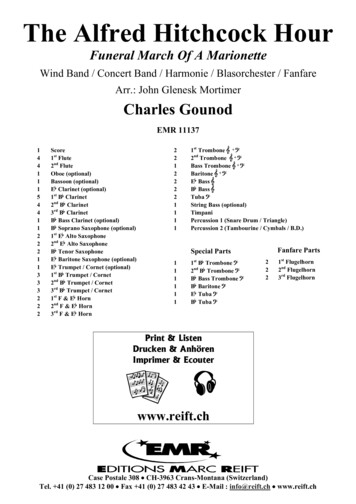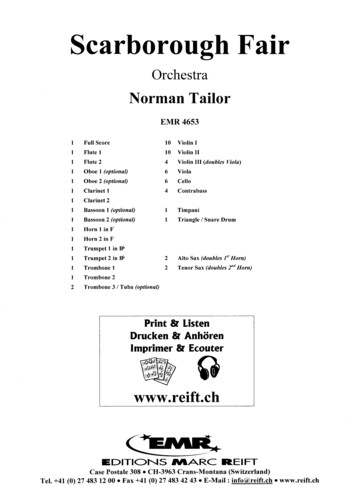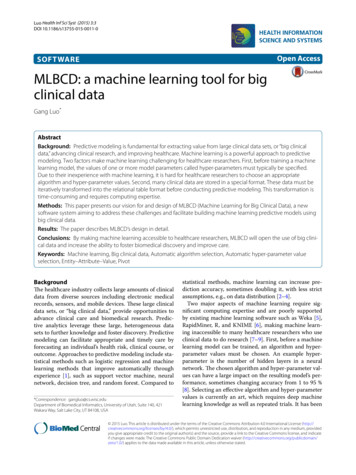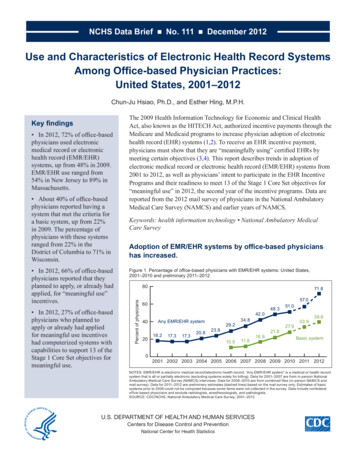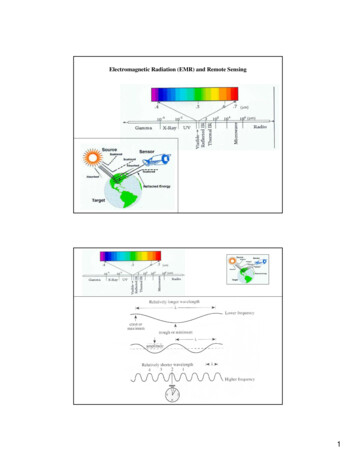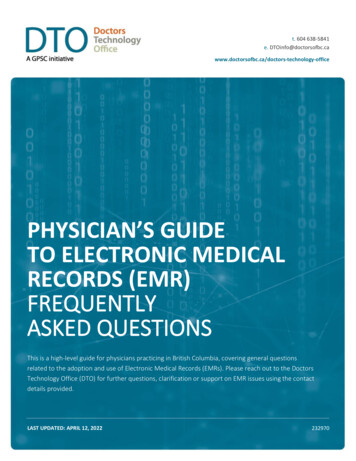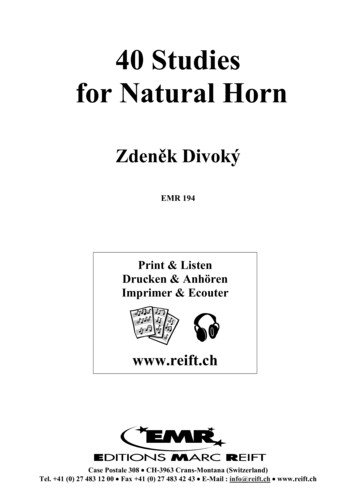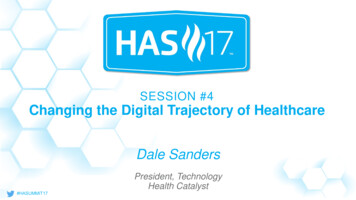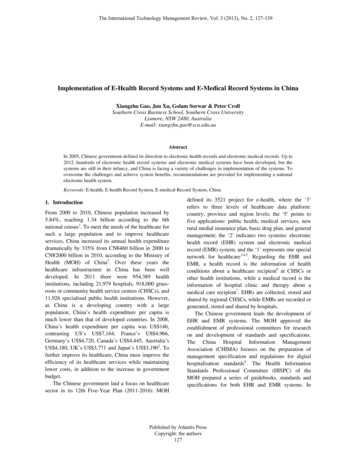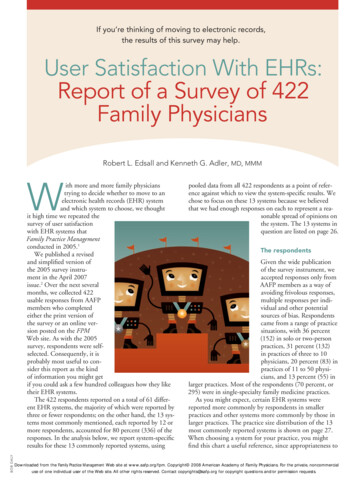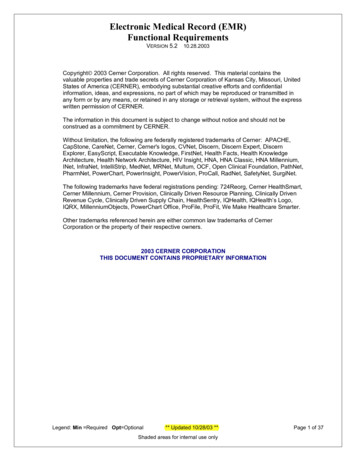
Transcription
Electronic Medical Record (EMR)Functional RequirementsVERSION 5.210.28.2003Copyright 2003 Cerner Corporation. All rights reserved. This material contains thevaluable properties and trade secrets of Cerner Corporation of Kansas City, Missouri, UnitedStates of America (CERNER), embodying substantial creative efforts and confidentialinformation, ideas, and expressions, no part of which may be reproduced or transmitted inany form or by any means, or retained in any storage or retrieval system, without the expresswritten permission of CERNER.The information in this document is subject to change without notice and should not beconstrued as a commitment by CERNER.Without limitation, the following are federally registered trademarks of Cerner: APACHE,CapStone, CareNet, Cerner, Cerner's logos, CVNet, Discern, Discern Expert, DiscernExplorer, EasyScript, Executable Knowledge, FirstNet, Health Facts, Health KnowledgeArchitecture, Health Network Architecture, HIV Insight, HNA, HNA Classic, HNA Millennium,INet, InfraNet, IntelliStrip, MedNet, MRNet, Multum, OCF, Open Clinical Foundation, PathNet,PharmNet, PowerChart, PowerInsight, PowerVision, ProCall, RadNet, SafetyNet, SurgiNet.The following trademarks have federal registrations pending: 724Reorg, Cerner HealthSmart,Cerner Millennium, Cerner Provision, Clinically Driven Resource Planning, Clinically DrivenRevenue Cycle, Clinically Driven Supply Chain, HealthSentry, IQHealth, IQHealth’s Logo,IQRX, MillenniumObjects, PowerChart Office, ProFile, ProFit, We Make Healthcare Smarter.Other trademarks referenced herein are either common law trademarks of CernerCorporation or the property of their respective owners.2003 CERNER CORPORATIONTHIS DOCUMENT CONTAINS PROPRIETARY INFORMATIONLegend: Min Required Opt Optional** Updated 10/28/03 **Shaded areas for internal use onlyPage 1 of 37
Electronic Medical Record (EMR)Functional RequirementsVERSION 5.210.28.2003Functions considered of primary importance have a dot ( ) in the “Min” column, indicatingthat the function described by the statement represents a minimum requirement. Featuresconsidered desirable but not mandatory have a dot ( ), in the “Opt” (Optional) column.The vendor should review each of these requirements against their proposed system.Where the function is provided, the vendor should indicate that capability by placing an“X” in the “Yes” column, followed by the name of the proposed software module or menufunction that provides the stated capability under the Module Name column.If the proposed product does not currently satisfy the requirement but will in the future,enter version number and the approximate date it will be available in the Future Version &Date column (e.g. V3.1/May 2004).If the product does not satisfy the requirement but the vendor is aware of any third partyproduct that does satisfy the requirement and can be interfaced with the vendor’s product,enter the third-party product(s) name in the 3rd Party Provided (Name) column, providingthat the vendor has secured an agreement from the third party vendor that the product andits required interface(s) will be provided. Note that the vendor submitting the proposalshall be responsible for all third party products included in the proposal.Legend: Min Required Opt OptionalShaded areas for internal use onlyPage 2 of 37
Electronic Medical Record (EMR)Functional RequirementsVERSION 5.210.28.2003VENDOR PROFILECerner CorporationA. Company Name:2800 Rockcreek ParkwayB. Address (City, State, Zip):Kansas City, MO 64117C. Contact Name:Kevin McDonald, Advisory Client ExecutiveD. Contact Phone:407-616-6318E. Contact Fax Number:816-571-2840F. Contact E-mail Address:kmcdonald@cerner.comG. Company Web Site:www.cerner.comH. Annual Revenue: 751,852,000I. Years in Business:Cerner has been in business for 24 years.J. Years Serving Community Health CareCerner’s Physician Practice software,PowerChart Office, was first released in 1997.Market:Cerner has clients around the world. The clientparticipation ranges from single systems to theK. Total Current Health Care Customers:full suite of Cerner Millennium systems.Cerner has 231 clients at 528 sites, running2,399 Cerner Millennium applications.L. Total Current Community HealthCenter Customers:Cerner has two community health center clientswith one to many sites having installedPowerChart Office.M. Electronic Medical Record (EMR)PowerChart Clinical OfficeLegend: Min Required Opt OptionalShaded areas for internal use onlyPage 3 of 37
Electronic Medical Record (EMR)Functional RequirementsVERSION 5.210.28.2003Product Name(s):Cerner's largest client currently using ourPowerChart Clinical Office solution has moreN. Largest System Installed (in terms ofthan 4,000 users at 38 sites. This particularnumber of users and sites):client has implemented PowerChart ClinicalOffice with PowerNote as well as our practicemanagement solution, PowerChart SupportOffice.O. Product Licensing Terms:All clients pay Monthly Licensed SoftwareSupport fees for the ongoing use of their Cernersoftware system. These fees apply only toCerner licensed software and are not forhardware (equipment) or sublicensed softwaresupport. These monthly support fees are Is Maintenance Included?collected one month in advance and fund ourservices delivery organizations (Client Services)as well as the development of future releasesand improvements to Cerner software. TheMonthly Licensed Software Support fee entitlesthe client to continuous support, includingperiodic updates of the licensed softwareproducts. Is Training Included?YesCerner plans to introduce a new major releaseevery 18 - 24 months. The next scheduledrelease is Cerner Millennium 2004.01; scheduledfor Q1 2004.P. Frequency of UpgradesInstallation of revisions and updates is the client’sresponsibility; it does not require Cerner’sassistance.Legend: Min Required Opt OptionalShaded areas for internal use onlyPage 4 of 37
Electronic Medical Record (EMR)Functional RequirementsVERSION 5.210.28.2003Revisions are cumulative to include any fixes,modifications and improvements. Clients arenotified of these revisions via e-mail.Alternatively, the Cerner Desktop Manager canbe configured to automatically “keep current” onCerner software. When a new revision ofsoftware is placed in the repository, a PC utilizingthe Desktop Manager can automaticallydownload the new version at the time of login.Because many revision levels require schemachanges, new rev levels are applied to a client'sMillennium system in their entirety. RevisionUpdates are engineered passively, to preservethe functionality of the previous automatedprogram interface (API) and do not introduceschema changes.The PowerChart Office Advisory Group,comprised of several PowerChart Office clients,meets on a quarterly basis. In addition, RegionalUser Groups are held on a quarterly basis.Cerner’s User Group is called the Cerner ClientCommunity. Membership in the Cerner ClientCommunity is available to all Cerner clients at nocharge.Q. User Groups:The Cerner Client Community serves a veryimportant role in shaping future productdevelopment plans. The Special Interest Groupsand Focus Groups within the user groupconcentrate on specific areas of the healthcareindustry and the potential impact of currenthealthcare issues on the Cerner systems. Thesegroups provide Cerner with input about futureenhancements and suggestions for making ourLegend: Min Required Opt OptionalShaded areas for internal use onlyPage 5 of 37
Electronic Medical Record (EMR)Functional RequirementsVERSION 5.210.28.2003products even more versatile and adaptable.The Cerner Client Community is a highlymotivated and functional advisory group toCerner.In 1998, all Cerner clients were made membersof the Cerner Client Community. Prior to 1998Cerner clients paid to receive this beneficialmeans of communication, however clients arenow able to participate in this community free ofcharge. Current members include radiologists,pharmacists, physicians, information systemdirectors, database coordinators, respiratorytherapists, medical records personnel,histotechnologists, cytotechnologists,pathologists, medical technologists, radiologytechnologists, pharmacy technologists, nurses,and healthcare executives representing all areasof healthcare.Regional User Groups (RUGs)RUGs were developed to allow bettercommunication between clients within a region toaddress enterprise-wide issues such astechnology, Cerner's new initiatives, and regionalsupport. This is a unique low-cost opportunity forour clients to gain knowledge on their specifictopics of interest.Each Regional User Group has a RUGchairperson, who is a Cerner client. The RUGchairperson is responsible for holding RUGmeetings throughout the year and contributingarticles for the Regional newsletter.Legend: Min Required Opt OptionalShaded areas for internal use onlyPage 6 of 37
Electronic Medical Record (EMR)Functional RequirementsVERSION 5.210.28.2003Special Interest Groups (SIGs):Special Interest Groups were created to promotebetter communication between clients within aparticular domain and to address specific issues.SIGs hold meetings throughout the year atnational and international conventions. SIGsmay also choose to hold up to twoteleconferences annually and are encouraged tocommunicate with their SIG constituency via listserves on CKN throughout the year. All of theseopportunities allow knowledge sharing withcolleagues and enable Cerner Client Communitymembers to stay abreast of the Company's mostrecent announcements and achievements.While the Cerner Client Community is anorganization independent of Cerner, we provideassistance to the group. Cerner and the usersenjoy a complementary yet independentrelationship. Cerner supports the user group withvarious administrative activities and works closelywith the group to develop domain specificsessions at the Cerner Health Conference. Inexchange, Cerner receives the benefits ofworking with an active group of users andreceiving invaluable input from this group on thefuture direction of clinical information systems.Overall, the relationship has enjoyed greatsuccess over the years.Legend: Min Required Opt OptionalShaded areas for internal use onlyPage 7 of 37
Electronic Medical Record (EMR)Functional RequirementsVERSION 5.210.28.20031.General92.Demographics103.Medical History114.Current Health Data, Encounters, Health Risk Appraisal135.Encounter – Progress Notes176.Problem Lists197.Clinical Practices Guidelines (CPG)218.Care Plan229.Prevention2210.Patient dications2815.Confidentiality and Security3016.Decision Support3017.Cost Measuring/Quality Assurance3118.Disease Management/Clinical Registries3419.Technical3520.Clinical IT Data Dictionary3621.Input Mechanisms3622.No Section23.Ergonomic Presentation3724.Implementation and Support37Legend: Min Required Opt OptionalShaded areas for internal use onlyPage 8 of 37
Electronic Medical Record (EMR)Functional RequirementsVERSION tMinVendor CapabilitiesModule NameXPowerChart ClinicalOffice withPowerNote3rd PartyProvided(Name)GeneralA. The system supports both a total paperless functionand a hybrid function, where the contents of theelectronic record can be printed for inclusion in thepaper chart PowerChart ClinicalOffice withPowerNote*Cerner is capable of linking with a variety of digital and analog dictation systems, for the output of transcription systems, viaan HL7 interface. Interface specifics would need to be discussed further.PowerChart ClinicalOffice withX C. The system date and time stamps all entriesPowerNoteB.The system links with a variety of digital and analogdictation systems D. The system includes automatic translation of codes toX**data. For example:*With a subscription to Cerner Medical Terminology (CMT), Cerner Millennium provides automatic translation of codes to data.PowerChart ClinicalXOffice with ICD-9-CMPowerNotePowerChart ClinicalXOffice with CPT (4 and 5)*PowerNote*CPT-5 will be supported in the future.PowerChart ClinicalTo beOffice with ICD-10Determined*PowerNote*ICD-10 will be available when it becomes industry standard.PowerChart Clinical SNOMED (II and III)XOffice with *PowerNote*Cerner supports SNOMED II and III for our laboratory (PathNet) clients. SNOMED CT is supported as the broad clinicalterminology for Cerner Millennium. APGPowerChart ClinicalOffice withPowerNote/ NDCMediSourceFoundationPowerChart ClinicalE. The system includes support and regular updates forXOffice with the above vocabularies.*PowerNote*With a subscription to the Cerner Medical Terminology (CMT), we supply the annual updates and mapping for externalvocabularies including DRG, ICD-9-CM, CPT-4, SNOMED CT, NIC/NOC, NANDA, LOINC, APC, HCPCS and ready theadministrative and clinical terminologies for import into Cerner Millennium. The clinical and administrative terminologies areupdated in accordance with the various source organizations’ distribution timetable. Your organization is responsible for theinstallation of the update, which is available on the Cerner Knowledge Network for download. Per the AMA, if CPT-4 codes areused within Cerner Millennium applications, the codes must be licensed through Cerner.PowerChart Clinical F. The system supports local, regional, and nationalOffice withXLegend: Min Required Opt OptionalShaded areas for internal use onlyPage 9 of 37
Electronic Medical Record (EMR)Functional RequirementsVERSION 5.210.28.2003vocabularies, updates and enhancementsG. The system supports the HIPAA Standards for Electronic TransactionsH. The system includes the integration of third party coding programsI.The system includes extensive error checking of alluser input data, including, but not limited to:Module NameXOffice withPowerNotePowerChart ClinicalOffice withPowerNotePowerChart ClinicalOffice withPowerNoteXX3rd ntOptMinVendor CapabilitiesX PowerChart ClinicalXOffice withInfoX*PowerNote*PowerChart Clinical Office with PowerNote provides Advanced Beneficiary Notification (ABN) checking. This allows cliniciansto be notified if the procedure and diagnosis do not match up for Medicare payment based on database information. When thishappens, an ABN form can be printed for the patient to sign stating that he or she understands that Medicare will not pay andthey are responsible for payment. Licensing of InfoX is required for ABN checking or your organization can choose to builddiagnosis and procedure pairs.PowerChart ClinicalXOffice with ICD-9 procedure checking against diagnosisPowerNote/DiscernExpertPowerChartClinical Extensive date checking for validity as well asXOffice withensuring a valid chronological order of events (dxPowerNote/Discernbefore treatment, scheduling after birth, etc.)Expert J.ICD-9 (Check diagnosis against gender, age,other as necessary)The system includes an integrated standardnomenclature of clinical terms. XK. The system provides sufficient storage and processingpower to efficiently operate on the initial patient loadplus 5% yearly growth for five (5) years withoutadditional hardware.PowerChart ClinicalOffice withPowerNote*See comments * Using statistics and formulas we can closely determine a number of system requirements including the size of the data centerCPU and the amount of memory needed. Using this information, a Cerner System Consultant designs a system specific for theneeds of your organization. Cerner’s System Consultants are extremely accurate in hardware configurations that are basedupon information from our clients. However, it is very important that the statistics and other processing information that youprovide to us are as accurate as possible in order to help ensure that we configure and propose a system that meets yourneeds, strategic objectives, and budget. The statistics are very important and if an error is made that results in inadequateprocessing power, Cerner will work with you to a mutually satisfying resolution.As with any RDBMS, as the database increases in size over time, and spreads across an increasing number of storage devices,the average amount of time necessary to access a single discrete data element increases as well.It is possible to design the initial hardware configuration so that the future enhancement stages can be incremental in nature.But it is not especially cost-effective to build a 'day one' data center that will protect the users from any performancedegradation for longer than this, however technically possible it may be.2.DemographicsA. The system has the capability of importing patientdhi d ti HL7 i t ffi ti XPowerChart ClinicalOffice withLegend: Min Required Opt OptionalShaded areas for internal use onlyPage 10 of 37
Electronic Medical Record (EMR)Functional RequirementsVERSION 5.210.28.2003demographic data via HL7 interface from an existingPractice Management System, Patient RegistrationSystem, or any such system used for patientregistration and/or schedulingYesRequirementOptMinVendor CapabilitiesModule Name*PowerNoteFutureVersion(Date)3rd PartyProvided(Name)*Cerner systems are capable of interfacing with any HL7 compliant system. Interface specifics would need to be discussedfurther.PowerChart ClinicalB. The system has the capability to import/create, review,XOffice withupdate, and delete patient demographic information as*PowerNote/ well as other non-clinical information from the patientPowerChart SupportrecordOffice*Demographic information can be imported and reviewed in PowerChart Clinical Office with PowerNote via an HL7 interface.Interface specifics would need to be discussed further. In addition, demographic information can easily be created, reviewedand updated in our practice management system, PowerChart Support Office. The ability to delete patient information is notsupported, however, the ability to inactivate is supported within Millennium. We can import patient demographic data from aforeign system at the person or encounter level.PowerChart ClinicalXOffice with*PowerNote/ C. The system captures permanent patient addressPowerChart SupportOffice*Permanent patient address can be captured with PowerChart Support Office. In addition, permanent patient address can becaptured with PowerChart Clinical Office with PowerNote via the appropriate HL7 interface. Interface specifics would need tobe discussed further.PowerChart ClinicalXOffice with*PowerNote/ D. The system captures temporary patient addressesPowerChart SupportOffice*Temporary patient address can be captured with PowerChart Support Office. In addition, temporary patient address can becaptured with PowerChart Clinical Office with PowerNote via the appropriate HL7 interface. Interface specifics would need tobe discussed further.3.Medical HistoryA. The system supports rapid capture of patient historyand physical exam dataB.For each new patient, the system captures and storesrisk factors. For example: Tobacco use and history including number ofyears and packs per day (PPD) Alcohol use, history Drug use, history XPowerChart ClinicalOffice withPowerNoteXPowerChart ClinicalOffice withPowerNote/PowerFormsXPowerChart ClinicalOffice withPowerNote/PowerFormsXPowerChart ClinicalOffice with Legend: Min Required Opt OptionalShaded areas for internal use onlyPage 11 of 37
Electronic Medical Record (EMR)Functional RequirementsVERSION 5.210.28.2003YesRequirementOptMinVendor CapabilitiesFutureVersion(Date)Module Name3rd PartyProvided(Name)PowerNote/PowerForms XOccupational environmentPowerChart ClinicalOffice withPowerNote/PowerFormsC. For each new patient, the system captures and storesthe following social history elements: Marital status Occupation Religious preference Socioeconomic status Native language Translator needed (Y/N) D. The system has the capability to import patient healthhistory data, including obstetrical history data, from anexisting system. XXXXXXX*PowerChart ClinicalOffice withPowerNote/PowerFormsPowerChart ClinicalOffice withPowerNote/PowerFormsPowerChart ClinicalOffice withPowerNote/PowerFormsPowerChart ClinicalOffice withPowerNote/PowerFormsPowerChart ClinicalOffice withPowerNote/PowerFormsPowerChart ClinicalOffice withPowerNote/PowerFormsPowerChart ClinicalOffice withPowerNote*Cerner systems are capable of interfacing with any HL7 compliant system. Interface specifics would need to be discussedfurther.E.The system documents hospitalization data including: Admission and Discharge dates X Chief complaint X Admitting diagnosis / Other diagnoses X Procedures performed XPowerChart ClinicalOffice withPowerNotePowerChart ClinicalOffice withPowerNotePowerChart ClinicalOffice withPowerNotePowerChart ClinicalOffice withPowerNoteLegend: Min Required Opt OptionalShaded areas for internal use onlyPage 12 of 37
Electronic Medical Record (EMR)Functional RequirementsVERSION 5.210.28.2003Yes Discharge summary X Discharge disposition XMinOptVendor CapabilitiesRequirementF.PowerChart ClinicalOffice withPowerNotePowerChart ClinicalOffice withPowerNoteThe system documents all existing allergies, such as: Drug X Food X Drug-drug X Drug-food X XG. The system captures history of receivedimmunizations.H. The system has the capability of linking or grouping records of other family members on file.4.FutureVersion(Date)Module NameI.The system has the capability to capture and storegenograms J.The system collects and stores family history,including, but not limited to: History of chronic diseases, including date ofdiagnosis X Disease status X Family member functional status If dead: date and cause of death XXPowerChart ClinicalOffice withPowerNotePowerChart ClinicalOffice withPowerNotePowerChart ClinicalOffice withPowerNotePowerChart ClinicalOffice withPowerNotePowerChart ClinicalOffice withPowerNotePowerChart ClinicalOffice withPowerNotePowerChart ClinicalOffice withPowerNoteTo beDeterminedTo beDeterminedPowerChart ClinicalOffice withPowerNotePowerChart ClinicalOffice withPowerNotePowerChart ClinicalOffice withPowerNote/PowerFormsPowerChart ClinicalOffice withPowerNote/PowerFormsCurrent Health Data, Encounters, Health Risk AppraisalA. The system obtains test results from laboratory,B.radiology / imaging, or other equipment or technologyrelated procedures via standard HL7 interface. The system has the capability to import/create, review,and amend information about the patient’s condition XPowerChart ClinicalOffice withPowerNoteX*PowerChart ClinicalOffice withLegend: Min Required Opt OptionalShaded areas for internal use onlyPage 13 of 373rd PartyProvided(Name)
Electronic Medical Record (EMR)Functional RequirementsVERSION 5.210.28.2003YesRequirementOptMinVendor CapabilitiesFutureVersion(Date)Module Name3rd PartyProvided(Name)obtained from laboratory, radiology/imaging, or other*Office withequipment or technology-related tests and/orPowerNoteprocedures.*Cerner systems are capable of interfacing with any HL7 compliant system. Interface specifics would need to be cal Outcomes,versionC. The system has the capability to capture and monitor Data Warehouse2004.01\patient health risk factors in a standard format.EstimatedavailabilityisQ1 04**Your organization can take data elements in Clinical Outcomes like diagnostic codes, procedure codes, and clinical events andcreate report level groupings and variables to use as risk factors. The Clinical Outcomes Solution Set is part of thePowerInsight decision support family of solutions.D. The system shall display encounter data using aproblem-oriented format.E.F. The system supports online completion of the HealthSurvey (SF-36) or similar measure for measuringhealth status and outcomes plotting of “Growth Chart” information, as well asother forms requiring graphic representation.PowerChart ClinicalOffice withPowerNoteXPowerChart ClinicalOffice withPowerNote/PowerForms The system includes plotter support capability.G. The system supports the capture, graphic display andXH. The system has the capability of reproducing andPowerInsightX edavailability isQ1 04PowerChart ClinicalOffice withPowerNotePowerChart ClinicalOffice withPowerNote/PowerForms*Your organization can create an unlimited number of PowerForms for patient and treatment forms. displaying a variety of end user patient and treatmentforms.I.The system has the capability to update other portionsof the record with captured vital signs data. Atminimum, the system collects: HeightX*XPowerChart ClinicalOffice withLegend: Min Required Opt OptionalShaded areas for internal use onlyPage 14 of 37
Electronic Medical Record (EMR)Functional RequirementsVERSION 5.210.28.2003YesRequirementOptMinVendor CapabilitiesFutureVersion(Date)Module NamePowerNoteJ. Weight Pulse Respiratory rate Blood pressure (including multiples) Different position blood pressure Other The system incorporates one or more acceptedmeasure of functional level.K. The system supports at least one standard healthstatus measure.L. XPowerChart ClinicalOffice withPowerNoteXPowerChart ClinicalOffice withPowerNoteXPowerChart ClinicalOffice withPowerNoteXPowerChart ClinicalOffice withPowerNoteXPowerChart ClinicalOffice withPowerNoteXPowerChart ClinicalOffice withPowerNoteXPowerChart ClinicalOffice withPowerNoteXPowerChart ClinicalOffice withPowerNotePowerChart ClinicalOffice withPowerNote*PowerForm data entry can calculate and store automatic health status measurements.The system stores automatic measurements of healthstatus. X*M. The system has the capability to import/create, review,update, and amend health data (objective andsubjective) regarding the patient’s current healthstatus, including (as applicable): Chief complaint Onset of symptoms Injury mechanism XPowerChart ClinicalOffice withPowerNoteXPowerChart ClinicalOffice withPowerNoteXPowerChart ClinicalOffice withLegend: Min Required Opt OptionalShaded areas for internal use onlyPage 15 of 373rd PartyProvided(Name)
Electronic Medical Record (EMR)Functional RequirementsVERSION 5.210.28.2003YesRequirementOptMinVendor CapabilitiesFutureVersion(Date)Module Name3rd PartyProvided(Name)PowerNote Physical examination findings Psychological and social assessment findings XPowerChart ClinicalOffice withPowerNoteXPowerChart ClinicalOffice withPowerNoteXPowerChart ClinicalOffice withPowerNoteXPowerChart ClinicalOffice withPowerNoteXPowerChart ClinicalOffice withPowerNotePowerChart ClinicalOffice withPowerNoteN. The system provides a flexible mechanism for retrievalof encounter information that can be organized invariety of ‘views’. For example: By name (last, first; first, last; etc.) By date of birth Chronological by encounter date By diagnosis, problem, problem type By chart number By family group / linkage X O. The system provides a flexible, user modifiable,search mechanism for retrieval of information capturedduring encounter documentation. X*PowerChart ClinicalOffice withPowerNotePowerChart ClinicalOffice withPowerNoteTo BeDeterminedTo BeDeterminedPowerChart ClinicalOffice withPowerNote*Our structured clinical documentation solution, PowerNote, is searchable.P.The system provides a mechanism to capture, review,or amend history of current illness.Q. The system ensures dynamic documentation duringthe encounter complying with all standard coding rules XPowerChart ClinicalOffice withPowerNoteX*PowerChart ClinicalOffice withPowerNote*PowerNote’s Care Design templates present appropriate documentation choices based on complaint, age and sex, accordingto the Center for Medicare and Medicaid Services (formerly HCFA) documentation standards to encourage consistent highquality documentation. Your organization can specify recommended documentation elements for each complaint.R. The system captures the following referral information:Legend: Min Required Opt OptionalShaded areas for internal use onlyPage 16 of 37
Electronic Medical Record (EMR)Functional RequirementsVERSION 5.210.28.2003 Type of referral Date Reason Provider FutureVersion(Date)YesRequirementOptMinVendor CapabilitiesModule NameXPowerChart ClinicalOffice withPowerNoteXPowerChart ClinicalOffice withPowerNoteXPowerChart ClinicalOffice withPowerNotePowerChart ClinicalOffice withPowerNoteX3rd PartyProvided(Name)X*PowerChart ClinicalOffice withPowerNote*PowerChart Clinical Office with PowerNote is capable of recording when consultations and referrals are made. Your definitionof ‘tracking’ is requested to respond appropriately.5.S.The system tracks consultations and referrals T.The system has the capability of printing consultations/ referrals forms XPowerChart ClinicalOffice withPowerNoteEncounter – Progress NotesA. The system records progress notes utilizing aPowerChart ClinicalOffice withPowerNote*PowerNote is our unique, patented Structured Clinical Documentation function. PowerNote allows physicians to review thepatient record, document, and order from one screen and utilizes problem-specific templates called Care Designs or encounterpathways. A series of options or smart pick lists present symptom-, guideline-relevant documentation and plan elements. Theencounter pathways present recommended options, but allow the physician to select the appropriate actions by point-and-clickwith a mouse or pen. A textual clinical note is created, accurately and instantly, as a by-product of care. Documentationcreated within PowerNote is saved as discrete structured data to allow future analysis.combination of system default, provider customizable,and provider-defined templates.B.The system has the capability to automatically updateother sections of the record with data entered in theprogress noteC. The system requires that the progress note be X*XPowerChart ClinicalOffice withPowerNotePowerChart ClinicalOffice withPowerNote*The system allows a PowerNote to be electronically signed; however,
Cerner's Physician Practice software, PowerChart Office, was first released in 1997. K. Total Current Health Care Customers: Cerner has clients around the world. The client participation ranges from single systems to the full suite of Cerner Millennium systems. Cerner has 231 clients at 528 sites, running 2,399 Cerner Millennium applications.
